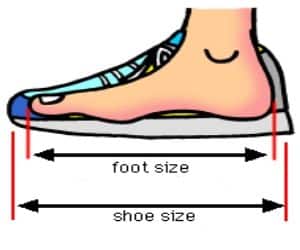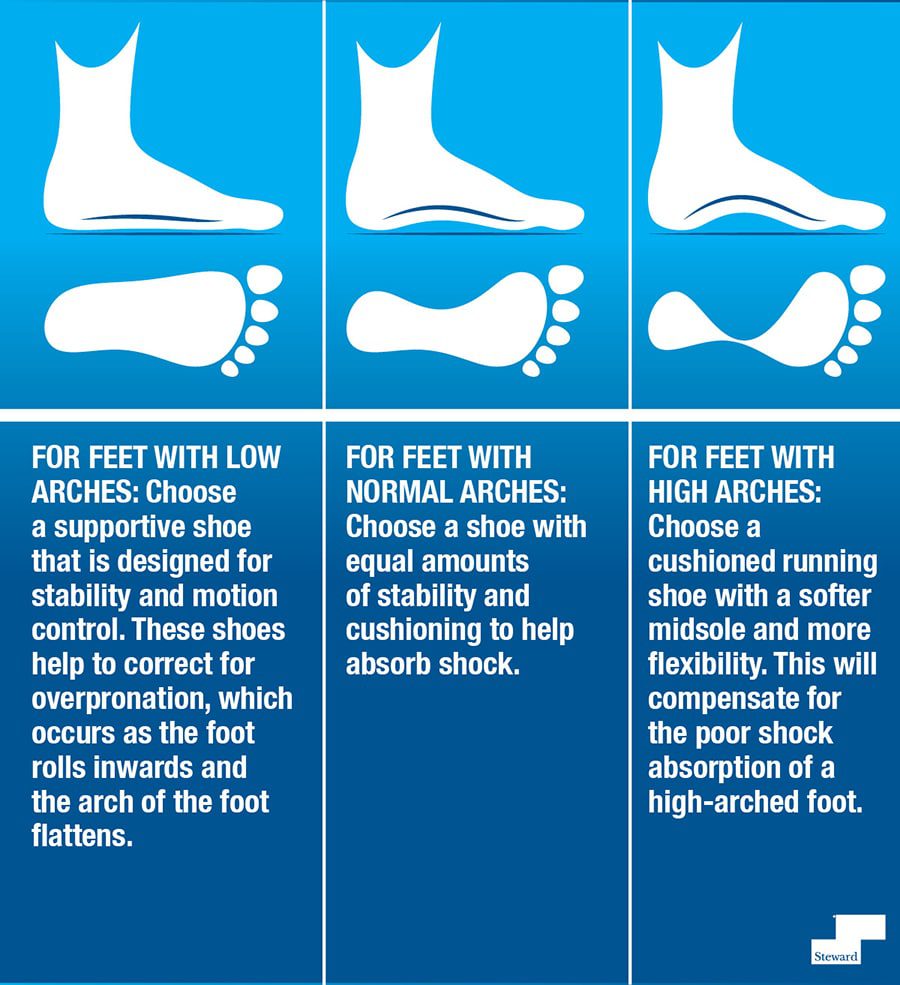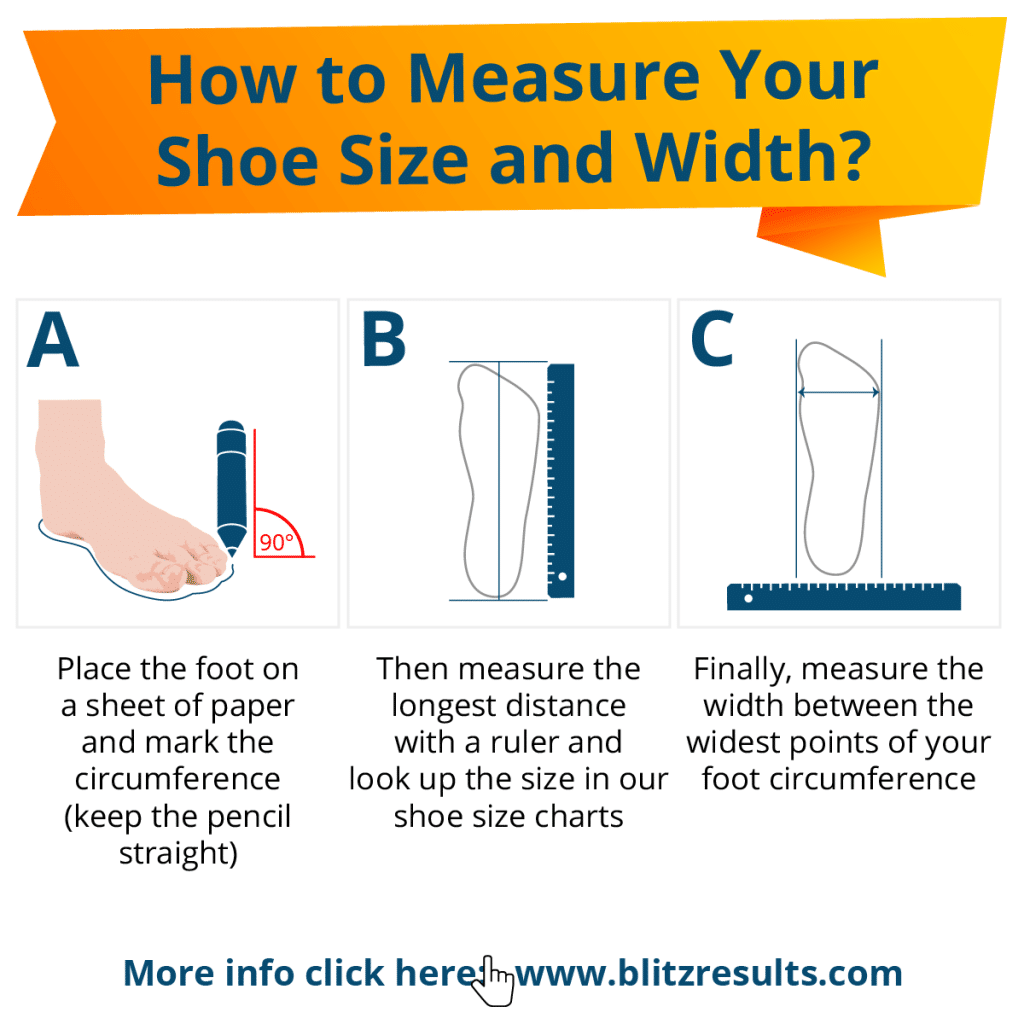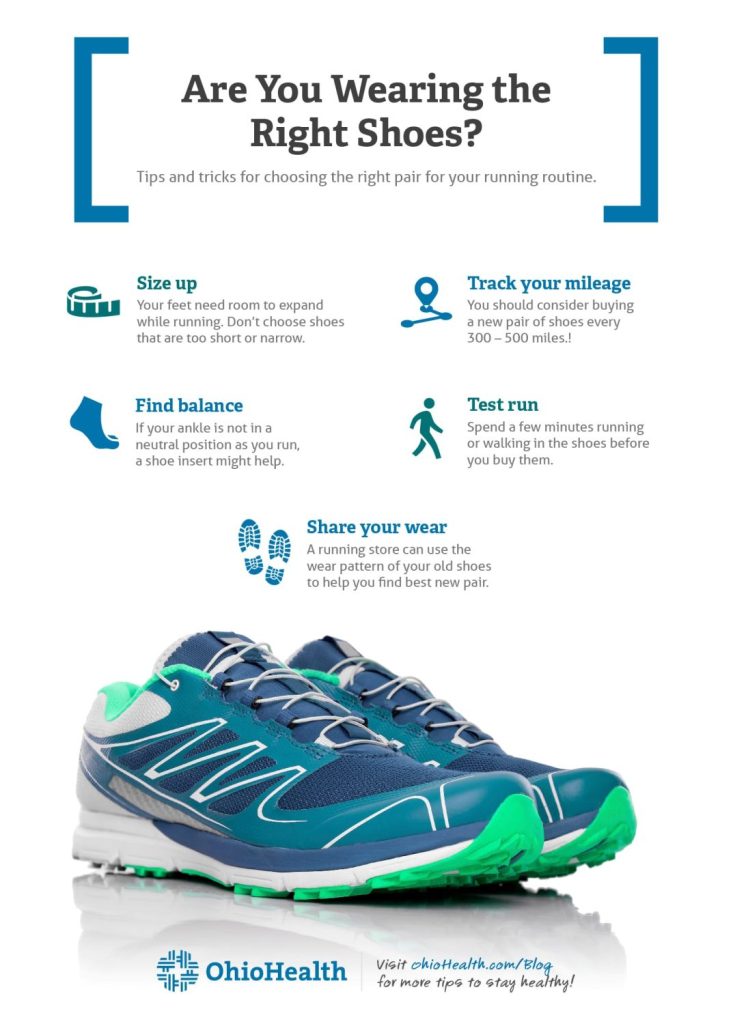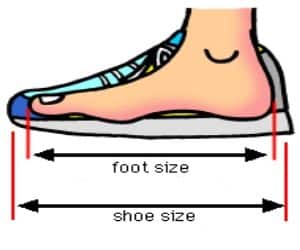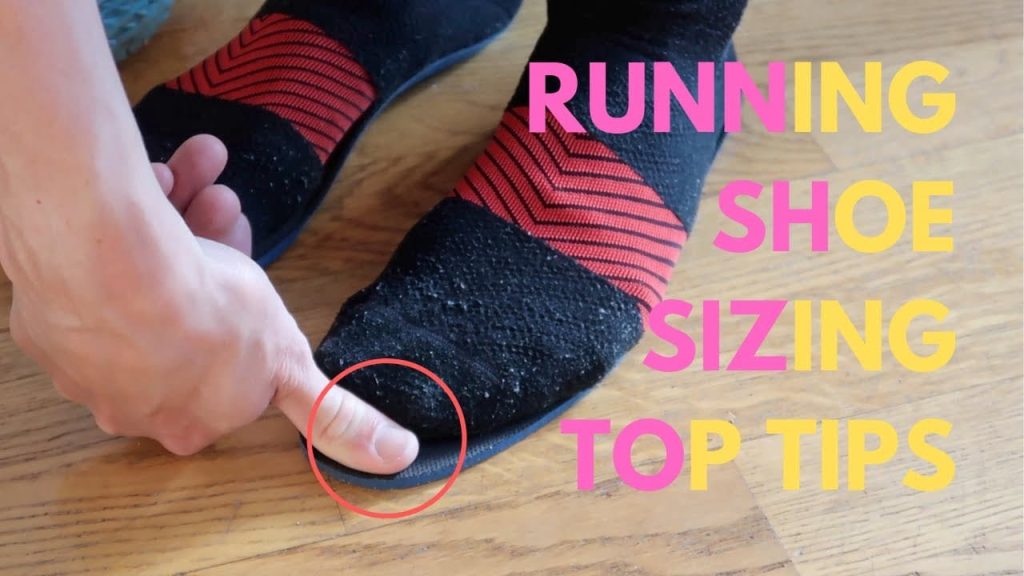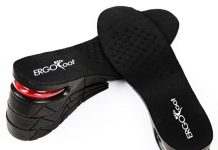Running shoes are a crucial component of the avid runner’s gear, but selecting the proper size can be daunting.
With countless options available, it’s essential to find a pair that fits comfortably and supports your feet during those long runs.
This article will provide essential tips on choosing the right size for your running shoes, ensuring a comfortable and enjoyable running experience every time.
Understanding Your Foot Shape and Size
Determining the Length of Your Foot
When finding the right size for your running shoes, understanding the length of your foot is crucial. Start by placing your foot on a piece of paper to measure the length accurately. Make sure your heel is against a wall or straight edge.
Then, mark the farthest point of your toe. Use a ruler or tape measure to measure the distance in inches or centimeters from the heel to the toe mark. This measurement will give you an idea of your foot length and help you determine the appropriate shoe size.
Measuring the Width of Your Foot
Along with the length, the width of your foot also plays a significant role in finding the perfect fit. To measure the width, wrap a measuring tape around the widest part of your foot, typically near the ball of your foot.
Ensure the tape is snug but not overly tight, as this can affect the accuracy of the measurement. The recorded measurement will help you determine the appropriate width for your running shoes.
Identifying Pronation Type
In addition to knowing the length and width of your foot, it’s essential to identify your pronation type. Pronation refers to your foot’s natural inward rolling movement as it strikes the ground while walking or running.
Understanding your pronation type will help you choose the right running shoe with the appropriate stability and support. You can identify your pronation type by conducting a wet test or consulting a podiatrist or foot specialist.
Importance of Proper Sizing
Enhanced Comfort and Performance
Wearing running shoes the right size for your feet can significantly enhance your comfort and overall running performance.
Ill-fitting shoes may lead to discomfort, blisters, or foot pain, ultimately hindering your running experience. By wearing shoes that fit correctly, you can avoid discomfort or pain, allowing you to focus on your stride and achieve optimal performance.
Prevention of Foot Injuries
Another crucial reason to ensure the proper sizing of your running shoes is injury prevention. Shoes that are too small or too big can lead to various foot problems, such as bunions, plantar fasciitis, or Achilles tendonitis.
Too tight shoes may restrict natural movement, while oversized shoes may cause instability. Both scenarios increase the risk of injuries. Investing in accurately sized shoes will help reduce the likelihood of foot-related injuries during your running sessions.
Optimal Support and Stability
Properly sized running shoes provide the necessary support and stability for your feet and ankles. Shoes that are too loose can result in inadequate support, leading to potential misalignment or instability.
On the other hand, shoes that are too tight may restrict natural movement and cause discomfort. By selecting shoes that fit correctly, you can ensure your feet and ankles receive the proper support, minimizing the risk of strains or sprains.
Factors to Consider
Arch Type
Understanding your foot’s arch type is essential for selecting shoes that provide the appropriate support. You can determine your arch type by performing a quick wet test. Wet the soles of your feet, then step onto a piece of paper or a surface showing your footprints.
You likely have a high arch if your footprint shows a distinct curve along the inside edge. A flat footprint indicates a low arch, while a moderate curvature suggests a normal arch. Knowing your arch type will help you choose shoes with the right level of arch support.
Toe Room
When trying on running shoes, make sure you have adequate toe room. Your toes should have enough space to wiggle comfortably without feeling cramped. Shoes that are too tight in the toe area can lead to blisters, bruised toenails, or other discomforts during your runs. Ensure a thumbnail’s width is roughly between the end of your longest toe (usually the big toe) and the front of the shoe.
Sock Thickness
Consider the thickness of the socks you typically wear during your runs. Thicker socks may require more room, so consider this when trying on shoes. If you typically wear thin socks, be mindful of not selecting a shoe that is too large, as this may cause your foot to slip inside the shoe while running.
Running Surface and Terrain
Think about the type of surfaces and terrains where you will be running. A shoe with adequate cushioning and support may be more suitable if you primarily run on pavement or track surfaces. If you prefer trail running, a shoe with aggressive tread and added stabilizing features can help provide better traction and protection.
Time of Day and Swelling
It’s important to consider that your feet can swell throughout the day or during longer runs. Therefore, measuring and trying on shoes later in the day when your feet are slightly swollen is often recommended. This will ensure you choose a shoe size that accommodates swelling and prevents discomfort during your runs.
Getting Accurate Measurements
Visit a Specialist Store
One of the best ways to get accurate measurements for your running shoes is by visiting a specialist store. Many shoe stores have trained staff who can measure your feet correctly. They will consider the length and width measurements and your pronation type, helping you find the right shoe size and type for your needs.
Use a Foot Measuring Device
If visiting a specialist store is not feasible, consider using a foot-measuring device at home. These devices are designed to measure your feet’ length and width accurately. Be sure to follow the provided instructions carefully to get the most precise measurements possible.
Follow Measuring Guidelines
Whether you visit a specialist store or use a foot-measuring device, following the provided measuring guidelines is crucial.
Different shoe brands may have slightly different measurement systems, so it’s essential to take accurate measurements specifically for the brand you are interested in. Following the guidelines will ensure you choose the correct shoe size and avoid unnecessary returns or discomfort caused by ill-fitting shoes.
Selecting the Right Shoe Size
Try Different Sizes
When choosing your running shoe size, it’s essential to try on different sizes and not rely solely on the size you typically wear in other footwear. Various shoe brands can have slight variations in sizing, and it’s crucial to find the size that fits your feet best. Try the larger and smaller sizes around your usual size to determine the best fit.
Consider Half Sizes
If a full-size shoe is too small or too big for your feet, consider trying a half-size. Sometimes, a half-size larger or smaller can provide a better fit, especially if you are between sizes. Pay attention to how the shoes feel when trying different sizes, ensuring enough room in the toe box and a secure fit around the midfoot and heel.
Check Both Feet
Most people have slight foot discrepancies, with one foot slightly larger. When trying on running shoes, check the fit and comfort of both feet individually. Choose the size that accommodates the larger foot to ensure optimal comfort and prevent potential issues.
Pay Attention to Comfort
Comfort should be a top priority when selecting running shoes. Even if a particular size fits your foot, it’s essential to consider how comfortable the shoes feel while standing, walking, or running. The shoes should feel snug but not overly tight, with no pressure points or rubbing areas that may cause discomfort over time.
Toe Wiggle Room
Ensure that you have enough toe room within the shoe. While the shoe should not be excessively loose, your toes should have reasonable space to move and wiggle comfortably. This room allows for natural foot movement during running and helps prevent issues such as toenail bruising or blisters.
Determining Width and Depth
Understanding Width Options
Running shoes are available in various width options to accommodate different foot sizes and shapes. Common width options include narrow (N), standard/medium (D), wide (W), and extra wide (XW). Understanding the width options can help you find a shoe that provides the right fit and prevents cramped toes or excessive foot movement.
Trying Various Widths
Try different width options if standard-width shoes do not fit your foot comfortably. Trying on shoes with broader or narrower widths can help you find a size that suits your foot shape more effectively. Assess the comfort and fit of each width option before making a final decision.
Evaluating Depth Needs
In addition to width, the depth of the shoe also plays a significant role in fit and comfort. Some individuals may have higher insteps or require additional depth to accommodate custom orthotic inserts. When trying on shoes, consider your foot’s depth needs and choose a shoe that provides adequate space without causing excessive looseness or discomfort.
Considering the Running Shoe Type
Neutral/Cushioned Shoes
Neutral or cushioned shoes are designed for runners with a regular foot arch and a relatively neutral pronation pattern.
These shoes provide good cushioning and shock absorption, ideal for runners who prefer a softer landing and a comfortable ride. If you have a neutral pronation and are looking for a comfortable shoe with ample cushioning, a neutral/cushioned shoe may be the right choice.
Stability Shoes
Stability shoes are suitable for mildly overpronated runners, meaning their feet tend to roll inward when running excessively. These shoes offer additional support features to help stabilize the foot and prevent overpronation. If you have mild to moderate overpronation, stability shoes can provide the necessary support and help correct your running gait, reducing the risk of injuries.
Motion Control Shoes
Motion control shoes are designed for runners with severe overpronation. These shoes have superior stability features, such as reinforced midsoles or medial posts, to control excessive inward rolling. Motion-control shoes may be your best choice if you have substantial overpronation and need maximum support and control.
Minimalist/Barefoot Shoes
Minimalist or barefoot shoes provide minimal cushioning and support, allowing for a more natural foot movement during running. These shoes suit runners who prefer a more barefoot-like experience and have developed strong foot muscles and efficient running mechanics. If you have a neutral pronation and want to strengthen your feet and lower legs, minimalist or barefoot shoes may be worth considering.
Trail Running Shoes
Trail running shoes are specifically designed for off-road running on uneven terrains. These shoes offer features like aggressive traction, durable soles, and added protection to withstand the demands of trail running. If you enjoy running in natural environments with rocky or muddy trails, trail running shoes will provide the necessary grip and stability for an enjoyable and safe running experience.
Consulting a Podiatrist or Foot Specialist
Seeking Professional Advice
If you have specific foot conditions, previous injuries, or unique foot biomechanics, consulting a podiatrist or foot specialist may be beneficial.
These professionals can assess your feet and advise you on the most appropriate running shoes. They may also recommend custom orthotic inserts or other interventions to optimize your foot’s function and prevent injuries.
Gait Analysis
A gait analysis is a diagnostic tool podiatrists or foot specialists use to assess your running or walking biomechanics. It involves observing your gait pattern, foot strike, and body alignment to identify any abnormalities or issues that may impact your running performance or lead to injuries. The specialist can recommend specific shoe features or types that suit your gait pattern and foot mechanics based on the gait analysis.
Custom Orthotic Evaluation
If you require additional support or correction for certain foot conditions or biomechanical abnormalities, a podiatrist or foot specialist can also evaluate the need for custom orthotic inserts.
These inserts are custom-made to fit the unique contours of your feet and can provide targeted support, stability, or correction. Consult a professional to determine if custom orthotics would benefit you and to ensure they are incorporated into your shoe selection process.
Importance of Trying on the Shoes
Physical Evaluation
Trying on running shoes is essential to assess the shoes’ physical characteristics and suitability for your feet. Look for features such as toe box width, arch support, cushioning level, stability features, and overall construction quality. By physically evaluating the shoes, you can determine if they meet your needs, preferences, and comfort requirements.
Test Run/Walk
While trying on running shoes, taking them for a short test run or walking within the store, if allowed, is highly beneficial. This allows you to experience the shoes in motion and assess their feelings during the activity. Pay attention to any areas of discomfort, rubbing, or instability during the test run. Trying different models or sizes may be necessary if the shoes do not feel comfortable or supportive.
Assessing Comfort and Fit
The final step in the shoe selection process is assessing the overall comfort and fit of the chosen shoes. Walk around the store wearing the shoes for a few minutes to gauge their comfort level.
Check for any pressure points, rubbing, or areas of discomfort. The shoes should feel secure and supportive, with no excessive movement inside the shoe or slippage in the heel area. Make sure you are satisfied with the overall fit before making your final decision.
Checking for Potential Issues
Toe Crowding
One common issue to check for is toe crowding. Ensure adequate room for your toes to move and splay naturally within the shoe. Tight-fitting shoes can lead to pain, numbness, or the development of bunions. Checking for toe crowding ensures your toes have sufficient space for proper foot mechanics and reduces the risk of foot-related problems.
Heel Slippage
When trying on running shoes, pay attention to any heel slippage. Your heel should fit snugly in the shoe without excessive movement or rubbing against the shoe’s back. If there is significant slippage, it may indicate that the shoe is too large or not suitable for your foot shape. Proper heel fit is crucial for stability and preventing blisters or discomfort during runs.
Pressure Points
Check for any pressure points or discomfort on your feet while wearing the shoes. Pay close attention to the sides of your feet, the tops of your toes, and the back of your heel. Pressure points can cause blisters or general discomfort, negatively impacting your running experience. Trying a different size or shoe model may be necessary if you notice any pressure points.
Arch Support
Assess the level of arch support provided by the shoes. The arch area should fit snugly against your foot and appropriately support your arch type. Look for shoes with higher arch support if you have a high arch. Conversely, aim for shoes with more flexibility or accommodating arch support if you have a low arch. Proper arch support helps distribute weight evenly and promotes efficient foot mechanics.
Overall Fit
Lastly, evaluate the overall fit of the shoes. They should feel secure and comfortable, with no areas of tightness, looseness, or discomfort. Pay attention to how the shoes feel while walking, jogging, or running.
Remember that your feet may swell slightly during activity, so a slightly roomier fit may accommodate longer runs. Choose running shoes that feel the most comfortable and supportive throughout various activities.
Choosing the right size and type of running shoes is crucial for your comfort, performance, and foot health. Understanding your foot shape and size and considering factors such as arch type, toe room, sock thickness, and terrain will help guide your decision.
You can find the perfect running shoes by getting accurate measurements, trying on different sizes and widths, and consulting professionals if needed.
Remember to prioritize comfort, support, and a proper fit while assessing the physical characteristics of the shoes. With the right running shoes, you can enjoy your runs while minimizing the risk of injuries and maximizing your performance.

